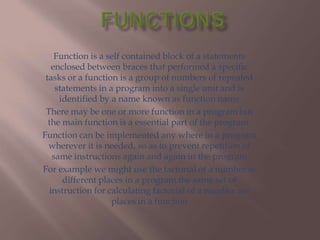
Shanks
- 1. Function is a self contained block of a statements enclosed between braces that performed a specific tasks or a function is a group of numbers of repeated statements in a program into a single unit and is identified by a name known as function name There may be one or more function in a program but the main function is a essential part of the program. Function can be implemented any where in a program wherever it is needed, so as to prevent repetition of same instructions again and again in the program For example we might use the factorial of a number at different places in a program the same set of instruction for calculating factorial of a number are places in a function
- 2. Function reduces the size of the program as repetition of instruction is reduced because these are written only once in a function that is instead of writing debugging and compiling the same set of instructions again and again the port can be re used. Function supports modular programming in which a large program is divided into smaller self contained parts. Each of which as a unique identification which makes the program easy to write understand debugging and maintained. Function promotes portability of a programs since function writing are independent of system dependent features Designing of large and complex programs becomes very easy and fast using function. This is because different functions can be involved In which it can be later combined to make the complex program, which results in reduction of time and cost Different data sets can be transferred to the function ,each time it is invoked which helps in saving a lot of memory space by allowing same set of statements to be used for different set of data In “c” language ,a function can call it self again ,this is known as
- 3. 1. Library function 2. User define function Library function : They are redefined and precompiled that are designed to perform for sum specific task. Information is passed to these functions through arguments and returned through the returned statement. for ex to calculate the square of a number and square root of a number power of a number and length of a string etc. Some of the library functions are print f, scan f , get character to upper() to lower() User defined function : They are those functions which programmer writes on his own as per the requirements in the program .So functions which are defined specifically by the user to meet his requirement are called user define function. Every “C” program contains at least one function that is main ( ) every function in “C” consist of following components (1) function definition (2) function declaration or function prototype (3) function call
- 4. An array is a finite ordered set of homogeneous elements. Arrays is used to handle a large amount of data without the need to declare many individual variables separately. All the array elements must be either of simple data types like integers float character double character etc or they can be any user defined data types like structure and unions
- 5. These are of three types 1. One dimensional arrays 2. Two dimensional arrays 3. Three or multi dimensional arrays One dimensional array: An array with one dimension is referred as one dimension array i.e. int a [ ] Two dimensional array: An array with two dimensional is referred as two dimensional array i.e. int a [ ] [ ]; two dimensional arrays results in a matrix of rows and columns Three or multi dimensional arrays: An array with more than two dimensions is know as multidimensional array. An array may consist of any number of dimension subjects to the restriction put by a compiler depend upon the language i.e. int a [ 3 ] [ 4 ] [ 5 ]
- 6. A string is a group of character which can be store in a character array many a time also called a string. A string is a collection of character‟s terminated by a null character „0‟. The null character indicates the end of the string. Each character that compose a string is stored in one dimensional char type array in contiguous memory locations for ex “Try Again” is a collection of character‟s „T‟ „R‟ „Y‟ „A‟ „G‟ „A‟ „I‟ „N‟ and terminated by a null character STRING VARIABLE: It is an array of character's that has a defined length. it can be used to store value #include <stdio.h> #include<conio.h>
- 7. Int strlen(s): This function takes one argument s which can be a string constant or a string variable. It returns the number of characters in the string s excluding the NULL character („0‟). If string is empty, it return zero.
- 8. A pointer is a variable that contains the address of another variable in memory. Suppose I is a integer variable having value 10 stored at address 2202 and address of I is assigned to variable j, then j is a pointer variable pointing to memory address stored in it. In other words, j is a pointer variable containing address of I (i.e.2002) Pointer variable is also known as address variable as it always store address of some other variable.
- 9. Data-type*ptr-var-name; Program demonstrate use of pointer variable and address of operator #include<stdio.h> #include<conio.h> main() {int I,*ptr; Clrscr(); i=5; Ptr=&I;/*store address of i*/ Printf(“value of i+%d”,i); Printf(“n address of i=%u”,$i); Printf(“nvalue of ptr=%u”‟ptr); Getch();